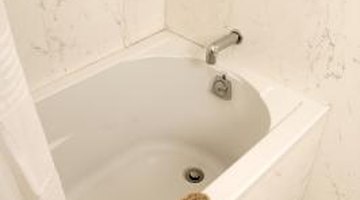How to Remove Caulk From Drywall
Caulking of any type is a highly adhesive substance. The material grabs onto and holds virtually any surface. Removing caulk from most surface, such as porcelain or tile, is relatively easy without damaging the surface. However, the porous nature of drywall, causes it to hold onto caulk, making it difficult to remove.

A razor blade, some spackle and spare paint can remove caulking without leaving any trace of the material.
Things You Will Need
- Single-edged razor blade
- Spackle
- Putty knife
- 120-grit sandpaper
- Paint
- Paintbrush
-
Press the edge of a razor blade flat against the drywall with the end of the blade pressed down against the caulking.
-
Slide the razor blade along the surface of the wall pressing down and through the caulking while maintaining the blade flat against the wall. Repeat the process to ensure that the connection of caulking to the wall was completely severed.
-
Peel the caulking off slowly. The caulking should remove without any damage at all to the drywall.
-
Repair any small points of damage with spackle. Spoon the spackle onto the wall with a putty knife smoothing the spackle over with the edge of the knife. Sand the surface of the spackle with 120-grit sandpaper and paint as necessary to hide the damage.
The Drip Cap
- Caulking of any type is a highly adhesive substance.
- Removing caulk from most surface, such as porcelain or tile, is relatively easy without damaging the surface.
- Slide the razor blade along the surface of the wall pressing down and through the caulking while maintaining the blade flat against the wall.
References
- "Lowe's: Complete Home Improvement and Repair"; Don Vandervort; 2005
Photo Credits
- Jupiterimages/Photos.com/Getty Images
- Jupiterimages/Photos.com/Getty Images
More Articles



